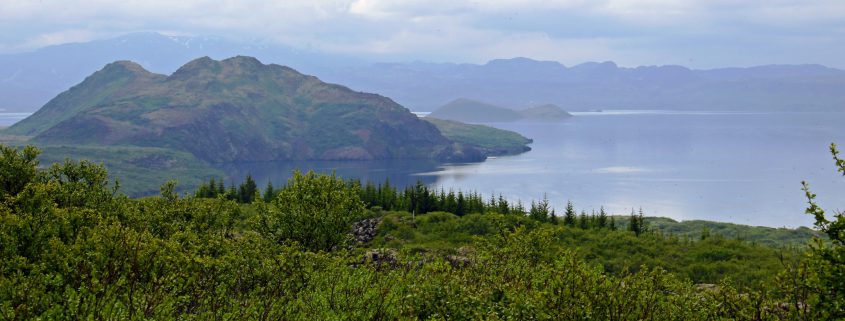
The fishing season in subarctic Iceland is relatively short. The fishing rhythm of the year was to start tying after new year – brooding in the dark waiting for the light and return of life. I tied my flies and fantasized about the coming season getting ready for the spring that might be there or not. In the north spring is not set to any date at all. When the migratory birds return spring is official. Certain birds have special meaning for us and the return of the Lóa (Golden Plover) will merit first mention during the evening news irrespective of what is going on in the world. Hearing the Plover calling first time each spring can bring on blurry vision in the most hardened of fly slingers. The return of the Kría (Arctic Tern) is also well received since now we can be fairly certain there will not be night frosts until next fall. The third important migrant for me is the Hrossagaukur (Galinago galinageo – Snipe). When the male dives in the air patrolling his territory, he sounds like a neighing horse (hence the name – hrossagaukur literally horse cuckoo). That this small bird can produce this remarkable sound fascinates me and it is always a joyous sound out in the fields whenever (If you have experienced the silence in the countryside following their departure you can imagine the joy of hearing the birds anew next spring).
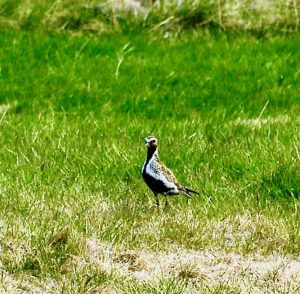
Golden Plover the harbinger of spring (DF)

Arctic Tern bringing food to the nest (DF)
Then when life returned off you went and kept going as long into the fall as possible. The summers demand a sub-manic phase and sometimes I fished until next morning (the lights were on, right?). This fix barely sustained me until next tying season rolled around. Within Reykjavik there are accommodatingly two trout lakes. One of them is very shallow Vífilsstaðavatn and therefore warms fast in the sunshine so aquatic critters start moving and the trout start feeding and cruising. This can happen in late March to April. Anglers are there pronto when the weather warms up (above freezing is good). Then there is a bigger lake called Elliðavatn that opens first of May holding both arctic char and brown trout. Both these lakes serve to steady you after the long dark winter, and it feels great to start there and get your cast and gear in order and the fly boxes sorted (typically you invent a new brilliant system each spring that spectacularly breaks down during the season so a new one is needed). These lakes are such treasures within the city and serve to keep one sane and lakes like that can be found many places around Iceland.
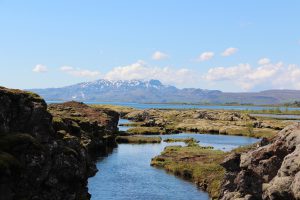
View from the north end of the lake towards south (DF)
Then there is the real McCoy Þingvallavatn (Lake Thingvellir) that is a unique place and a World Heritage Site since 2004. It is Iceland’s biggest lake 32 square miles and 367 feet deep and dips below sea level. The rivers that flow into this lake are small and the biggest part of its catchment water is through cold springs in the lakebed (90% estimated). The spring water is gin clear as is the lake. The runoff river is Efra Sog (3800 cubic feet per second) and lower down called Neðra Sog in itself a Salmon river but three waterfalls there (now with hydroelectric plants) can not be navigated by the salmonoids. The lake is ringed by some volcanic mountains of which the shield volcano Skjaldbreidur is the most distinctive. The area is one of majestic barren beauty year round. Needless to state that it can be bitterly cold there in the spring and the water temperature is just around 39F. We fish from outcroppings in the lava and wade out into the water on submerged lava ridges. You can bet the relief when neoprene waders replaced the rubber ones. Goretex waders are a bad idea any time of the year. Cold water can be quite disfiguring and downright scary! The other option is by belly boats. I have no experience of fishing the lake from a boat.

The shield volcano Skjaldbreiður (DF)
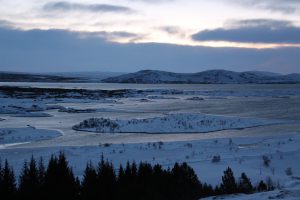
Þingvellir view over the national park area (DF)
The lake is 40 minutes drive from Reykjavik and that is where we were headed all the time the other ones just warm ups. This lake is absolutely one of a kind. The lake is in a graben exactly where the Eurasian tectonic plate is separating from the American tectonic plate. This is the place where you can see the earth being torn apart having one leg in Eurasia and the other in America! The surroundings are mostly lava that is very porous. The rain just disappears into the lava fields and then at the interfaces of lava layers it seeps forward towards the lake. It takes the water welling up in the cold springs in the lake bed hundreds of years to percolate through the lava layers. This water is clean, clear and soft with very little calcium and it has a steady temperature of just under 37-38F year round and it is potable.

Nikulásargjá one of the rifts at Þingvellir (DF)
The lake holds 4 morphs of Arctic Char that have evolved there in about 10.000 years from a single strain. The fish became landlocked there post last ice age. In the spring we were mainly fishing for a strain that specializes in water snails on the lake bottom in the littoral areas (Kuðungableikja or Bobbableikja). For that we use intermediate lines and try to stay just above the lake bottom that is lava. Understandably we snag and lose our flies often and as the saying goes “they strike just before you snag” is an apt one. The flies we use are simple bead heads or just something black and round like the water snails. Middle of summer the smaller trout called Murta will appear in huge numbers and now is the time to take kids fishing. They love catching these fish and we usually rig them up with a float and the fly 3 feet away. It takes time to connect with this lake and it took me many a fishless trip to figure it out and start to catch there regularly.
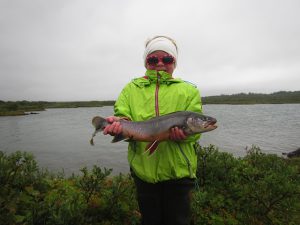
Arctic Char caught by Perla Sol
The Arctic Char spawns in the fall when the temperature falls. In Þingvallavatn (Lake Thingvellir) the temperature is steady year round in the cold springs just at 37F. Thus the Char there will spawn much earlier than usual. Huge schools of spawning fish can be seen from land and sometimes it looks like the fish are swimming towards a cave opening to disappear but in reality they are just disappearing into a ball of fish giving this illusion. The color of these fish is black from above and hard to see against a black lava bottom. The telltale sign is the white edge on the pectoral fins so it looks like white V from above. From the side these fish are sporting stunning colors. These lake holds so much fish that it is ok to harvest on or two as they are delicious.
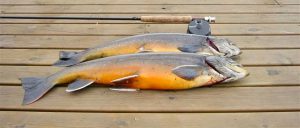
Arctic char with characteristic white stripes on its fins
The river flowing out of the lake southward is Efra Sog. This was the major spawning area of the biggest strain of the Brown Trout. The flow of the river and the Black Fly larvae there were optimal for the fish (Curiously Black Flies in Iceland are North American whereas the Midges or Gnat are European. There are no skeeters in Iceland). The absolute lurkers were caught there. In 1959 a hydroelectric damn was built at the outlet of the lake and the water routed through Dráttarhlíð to Úlfljótsvan to power Steingrímsstöð. There was an accident, and a damn gave way and the resultant flood destroyed the gravel beds used for these fish for spawning. This stock collapsed and has not recovered to my knowledge. However, the brown trout that by and large disappeared from our catches has reappeared and spawning occurs in small feeder rivers to the lake and in the autumn these fish are tagged and studied. It is seriously bad karma to to kill these fish.
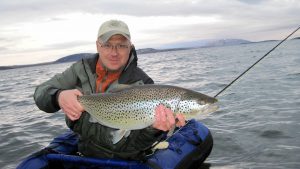
Ice age strain of brown trout caught by Sibbi
This is a strain of brown trout that has become landlocked after the rise of the earth’s crust post ice age. They are believed to have come the British Isles following the rising land. These brown trout are sea going and called Seatrout in the UK in America they are not widely known but the the sea run rainbows are called Stealhead. They have the remarkable characteristic that after gaining reproductive age they will spawn every other year and they will grow the off year. These fish can become very big because there is an abundance of food in the lake.
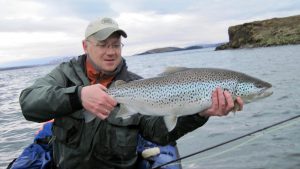
Ice age strain of brown trout caught by Sibbi
Sibbi is my fishing buddy and we have fished the lake countless times solo and together. This was the routine in the evening before. “You free tomorrow morning”? “Yup”. “How is the weather”? “Let´s check the weather station at Þingvellir. Not too bad 39F and calm”. Then we each packed rods, neoprene waders and flies and all the paraphernalia. We like fast rods (GLX Loomis) but not noddles and broomsticks. You become excited about the trip, and we were certain that we are going to catch a good fish. We thought about the flies which is not necessary at all because they are not the deciding factor there. We rose early and trembled with anticipation. We usually left Reykjavik early when the night revelers and drunk drivers were returning home from their escapades. One managed to sideswipe us and clipped our side mirror but we shrugged that off and continued undeterred. Then when we arrive calm descends upon us we move slowly and we listen and we look. There were mornings there when no birds could be heard working and singing. You know the feeling, everything is just dead. To be honest we really do not get upset at all. If this was the case, we did not even assemble our gear to go fishing. We know it is no use when nothing is moving. We sit and take in the scenery shoot the breeze a bit. Not casting or catching does not bug us. Angling has nothing to do with success. We just went with the mood of nature accepted it and moved on. We were just as happy with this outcome as with a “fishy” one. Then we return home but stop at the National Park shop and have a hot dog.
Pictures marked DF are my Wife’s Drífa Freysdóttir
- Þingvellir view over the national park area (DF)
- Arctic Tern bringing food to the nest (DF)
- Golden Plover the harbinger of spring (DF)
- View from the north end of the lake towards south (DF)
- Nikulasargja one of the rifts at Thingvellir (DF)
- Arctic Char caught by Perla Sol
- Arctic char with characteristic white stripes on fins
- Iceage strain of brown trout caught by Sibbi
- Iceage strain of brown trout caught by Sibbi
- Belly boat on Lake Thingvellir
- Lake Thingvellir (DF)
- The shield volcano Skjaldbreidur (DF)
Websites pertaining to Þingvellir
Research – Icelandic spoken in this video but the Brown Trout does not mind and neither should you
https://www.youtube.com/watch?v=8F3uNXPipus
Silfra is a diving site famous for its clear water
https://www.dive.is/dive-sites/silfra/
The national park website
http://www.thingvellir.is/english.aspx
Sibbi with a trout
Our favorite rods













